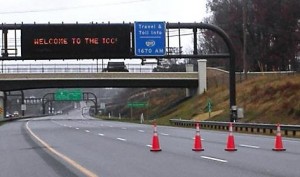
Andrews Calls for State to Cut ICC Tolls in Half (Video)
Montgomery County Council member Phil Andrews is requesting the Maryland Transportation Authority (MTA) to cut in half the tolls on the Inter-County Connector (ICC) to significantly increase use of the underused highway. Andrews has sent a letter to the Acting Chairman of MTA with his proposal.
The full ICC highway connecting I-270 in Gaithersburg to I-95 in Laurel opened one year ago with a system of variable tolls, depending upon the time of day. However, it has remained lightly used and has had little, if any, impact on relieving congestion on other roads, according to Andrews.
In 2009, MTA approved toll rates of $8 for rush-hour for end-to-end commutes on the 18-mile ICC by car. Trucks using the ICC face tolls as high as $36 for peak-hour, one-way, end-to-end trips, keeping many off the ICC and on local roads and highways.
 “Dec. 5, is the one-year anniversary of the implementation of the outrageously high ICC tolls since the ICC was fully open to the public,” said Andrews. “As I warned in 2009 when I testified before MTA about the proposed ICC tolls, the ridiculous ICC tolls discourage its use so much that the amount of traffic on the road more resembles that of an airport runway than a major highway. Given its $3 billion-plus cost [including debt financing], cutting the tolls in half would be a common sense, and necessary measure to encourage the public to use the highway.”
“Dec. 5, is the one-year anniversary of the implementation of the outrageously high ICC tolls since the ICC was fully open to the public,” said Andrews. “As I warned in 2009 when I testified before MTA about the proposed ICC tolls, the ridiculous ICC tolls discourage its use so much that the amount of traffic on the road more resembles that of an airport runway than a major highway. Given its $3 billion-plus cost [including debt financing], cutting the tolls in half would be a common sense, and necessary measure to encourage the public to use the highway.”
Andrews said the state highly miscalculated the willingness of the public to pay high tolls to use the ICC.
“ICC advocates, including Governor O’Malley, asserted that the ICC would take significant traffic off of local roads,” said Council member Andrews. “However, the ludicrous tolls approved by the MTA (whose members are appointed by the Governor) are a major deterrent to use of the highway. Unlike other MTA facilities, such as the Bay Bridge, the ICC inherently competes against nearby roads which do not have tolls. MTA foolishly assumed that ‘price was no object’ for the general public. This is obviously not the case. Demand for the ICC is elastic. Many people, whose tax dollars helped paid for this road, are unable to afford the tolls or are deterred by the high tolls—which undermines the ICC’s stated purpose of relieving congestion on other roads.”
Andrews opposed the construction of the $3 billion ICC as a poor use of scarce transportation dollars and for its severe environmental impact. In December 2005, he and other elected officials held a news conference to criticize the then-anticipated (in the State’s ICC Environmental Impact Statement) ICC toll rates of $7.20 for peak-hour, end-to-end commutes, stating that rates that high would discourage use.
“The state has tried very high tolls for a year and it has kept drivers off the road,” said Andrews. “It is time to try a reasonable level of tolls for a year and get people to use the road. This would be a more effective way to get traffic onto the ICC—and off other roads—than by buying ads in newspapers, which is the unsuccessful method the state has been using to attract users to the ICC.”

Engage us on Facebook
Follow us on Twitter
Tweets by @mymcmedia